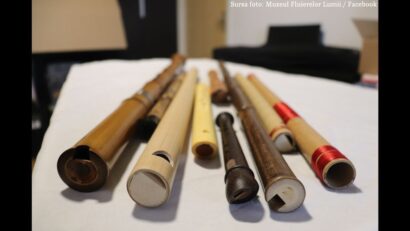Aida Vrioni, Romania’s first professional female journalist
Maria Mateescu by her real name, she was born in Ploiești in October 1880 and began publishing in her hometown.

Christine Leșcu, 19.06.2022, 14:00
The modernization of Romania, which had began in the second half of the 19th century, intensified around the First World War and got in tune with the West in the interwar period also due to a very special generations of intellectuals. Among them was Aida Vrioni, regarded as the first professional female journalist in Romania. Maria Mateescu by her real name, she was born in Ploiești in October 1880 and began publishing in her hometown, in the Aurora magazine, a publication founded by herself and her brother. Between 1898 and 1904 she contributed articles and literary works to several newspapers and magazines printed in Bucharest, such as Dimineața, Adevărul literar şi artistic and Rampa. In 1904, the renowned Romanian journalist Constantin Mille asked her to move to Bucharest and offered her the position of permanent editor with Adevărul newspaper, which made her the first professional female journalist in Romania.
In the interwar period she also became known as a prose writer, playwright and activist in women’s organizations that had flourished at the time. An important part of her activity took place in the editorial office of the Writer’s Magazine, which in 1929 became the Magazine of Romanian Writers. Aida Vrioni was its editor-in-chief from 1931 until the end of her activity, in 1943. Monica Negru, with the National Archives of Romania, has recently started to recover and publish Aida Vrioni’s writings. Monica Neagu: She was one of the feminist movements leaders at the time and had with various initiatives. She initiated and organized the first literary competitions for beginner writers, in order to support them financially and to stimulated them to write and publish. So her cultural endeavors were wide and diverse. As for her articles in Revista Scriitoarei and other publications, they were also extremely diverse. There were chronicles, articles about events, and a lot of material about her visits to different localities in the country. For example, she wrote about Bucharest, but also about Constanta and Sinaia .
Aida Vrioni combined journalism with drama and prose, with travel literature and feminism, and her frantic activity brought her a well-deserved recognition among the intellectuals. Nevertheless, when the magazine she wrote for was closed, she started to be forgotten. Monica Negru: “The magazine was edited and run by Aida Vrioni who always had appealed to contributors to write and publish. She wrote for the magazine but also financed it. She made many calls to her acquaintances to subscribe, to support the magazine.
In 1943, the magazine was no longer published because, most probably, Aida Vrioni did not have the means to finance it any longer. So she continued her work as a journalist and wrote for other publications of that time. It’s a strange thing. In the interwar years she was not only known but also appreciated by some of her fellow journalists. She also wrote two novels and a collection of essays, apart from press articles, but she is now completely forgotten. Her works have been abandoned in the archives.
The end of World War II found Aida Vrioni sick, but still writing in her diary. In 1950 she had a stroke that left her half-paralyzed until her death, in 1954. At present, Aida Vrioni’s work is brought back to the readers’ attention with her volumes of memoirs edited by Monica Negru.





























